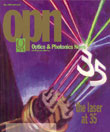
May 1995 Issue
Feature Articles
Breaking The Attosecond Barrier
Very short pulses of light enable researchers to probe never-before-observed phenomenon. Corkum describes how attosecond light pulses can be achieved.
by Paul CorkumSqueezed States: A Closer Look At The Amplitude And Phase Of Light
Generation and detection of non-classical states of light can now be routinely performed using various techniques. The simplest method: direct generation from a semiconductor laser, has recently attracted considerable attention because of potential applications and the underlying physics.
by Y. Yamamoto and W. H. RichardsonLasers For Art's Sake!
Modern laser technology can be successfully used to improve the conservation, non-destructive diagnostics, and composition analysis of paintings. In particular, excimer lasers are promising tools for surface cleaning of paintings, cleaning support material, such as canvas, paper, or wood, and recovering original paintings from overpaintings. The technique is based on the controllable removal of surface layers by photoablation.
by Costas FotakisOptics In The Fishtank
Why is the sky blue? Why are sunsets red? How does light travel through optical fibers? To answer these questions and others, we brought out a secret weapon: the fishtank. Using a 10-gallon tank ($10) and an inexpensive laser pointer ($40) or a He-Ne laser, a flashlight, and a ruler, we can show many sophisticated effects ranging from waveguiding to Rayleigh scattering. The OSA student chapter at Northwestern University has performed these interactive demos at local high schools to encourage interest in optics.
by Deana Rafizadeh and David Caplan
![Infinity Mirrored Room– Brilliance of the Souls 2014 by artist Yayoi Kusama. [© YAYOI KUSAMA]](https://opnmedia.blob.core.windows.net/$web/opn/media/images/articles/2024/0724/departments/202407-cover-web.jpg?ext=.jpg)
![An experimental scheme demonstrated by researchers at Princeton and Yale universities, USA, can convert physical noise into errors that can be corrected more easily. [F. Wojciechowski, Princeton University]](https://opnmedia.blob.core.windows.net/$web/opn/media/images/articles/2024/0624/departments/202406-cover-web.jpg?ext=.jpg)
